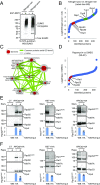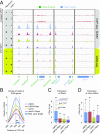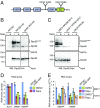TORC1-dependent sumoylation of Rpc82 promotes RNA polymerase III assembly and activity
- PMID: 28096404
- PMCID: PMC5293095
- DOI: 10.1073/pnas.1615093114
TORC1-dependent sumoylation of Rpc82 promotes RNA polymerase III assembly and activity
Abstract
Maintaining cellular homeostasis under changing nutrient conditions is essential for the growth and development of all organisms. The mechanisms that maintain homeostasis upon loss of nutrient supply are not well understood. By mapping the SUMO proteome in Saccharomyces cerevisiae, we discovered a specific set of differentially sumoylated proteins mainly involved in transcription. RNA polymerase III (RNAPIII) components, including Rpc53, Rpc82, and Ret1, are particularly prominent nutrient-dependent SUMO targets. Nitrogen starvation, as well as direct inhibition of the master nutrient response regulator target of rapamycin complex 1 (TORC1), results in rapid desumoylation of these proteins, which is reflected by loss of SUMO at tRNA genes. TORC1-dependent sumoylation of Rpc82 in particular is required for robust tRNA transcription. Mechanistically, sumoylation of Rpc82 is important for assembly of the RNAPIII holoenzyme and recruitment of Rpc82 to tRNA genes. In conclusion, our data show that TORC1-dependent sumoylation of Rpc82 bolsters the transcriptional capacity of RNAPIII under optimal growth conditions.
Keywords: RNA polymerase III; Sumo; TORC1; tRNA; transcription.
Conflict of interest statement
The authors declare no conflict of interest.
Figures








Similar articles
-
Regulation of tRNA synthesis by posttranslational modifications of RNA polymerase III subunits.Biochim Biophys Acta Gene Regul Mech. 2018 Apr;1861(4):310-319. doi: 10.1016/j.bbagrm.2017.11.001. Epub 2017 Nov 7. Biochim Biophys Acta Gene Regul Mech. 2018. PMID: 29127063 Review.
-
Differential Phosphorylation of RNA Polymerase III and the Initiation Factor TFIIIB in Saccharomyces cerevisiae.PLoS One. 2015 May 13;10(5):e0127225. doi: 10.1371/journal.pone.0127225. eCollection 2015. PLoS One. 2015. PMID: 25970584 Free PMC article.
-
RPC82 encodes the highly conserved, third-largest subunit of RNA polymerase C (III) from Saccharomyces cerevisiae.Mol Cell Biol. 1992 Oct;12(10):4433-40. doi: 10.1128/mcb.12.10.4433-4440.1992. Mol Cell Biol. 1992. PMID: 1406632 Free PMC article.
-
Sumoylation of Rap1 mediates the recruitment of TFIID to promote transcription of ribosomal protein genes.Genome Res. 2015 Jun;25(6):897-906. doi: 10.1101/gr.185793.114. Epub 2015 Mar 23. Genome Res. 2015. PMID: 25800674 Free PMC article.
-
Regulation of RNA polymerase III transcription by Maf1 protein.Acta Biochim Pol. 2008;55(2):215-25. Epub 2008 Jun 17. Acta Biochim Pol. 2008. PMID: 18560610 Review.
Cited by
-
Mitotic chromosome condensation resets chromatin to safeguard transcriptional homeostasis during interphase.Proc Natl Acad Sci U S A. 2023 Jan 24;120(4):e2210593120. doi: 10.1073/pnas.2210593120. Epub 2023 Jan 19. Proc Natl Acad Sci U S A. 2023. PMID: 36656860 Free PMC article.
-
DeSUMOylation of chromatin-bound proteins limits the rapid transcriptional reprogramming induced by daunorubicin in acute myeloid leukemias.Nucleic Acids Res. 2023 Sep 8;51(16):8413-8433. doi: 10.1093/nar/gkad581. Nucleic Acids Res. 2023. PMID: 37462077 Free PMC article.
-
Cdk1 gates cell cycle-dependent tRNA synthesis by regulating RNA polymerase III activity.Nucleic Acids Res. 2018 Dec 14;46(22):11698-11711. doi: 10.1093/nar/gky846. Nucleic Acids Res. 2018. PMID: 30247619 Free PMC article.
-
Specific Features of RNA Polymerases I and III: Structure and Assembly.Front Mol Biosci. 2021 May 14;8:680090. doi: 10.3389/fmolb.2021.680090. eCollection 2021. Front Mol Biosci. 2021. PMID: 34055890 Free PMC article. Review.
-
Novel Links between TORC1 and Traditional Non-Coding RNA, tRNA.Genes (Basel). 2020 Aug 19;11(9):956. doi: 10.3390/genes11090956. Genes (Basel). 2020. PMID: 32825021 Free PMC article. Review.
References
-
- Warner JR. The economics of ribosome biosynthesis in yeast. Trends Biochem Sci. 1999;24(11):437–440. - PubMed
-
- Desai N, et al. Two steps in Maf1-dependent repression of transcription by RNA polymerase III. J Biol Chem. 2005;280(8):6455–6462. - PubMed
-
- Vannini A, et al. Molecular basis of RNA polymerase III transcription repression by Maf1. Cell. 2010;143(1):59–70. - PubMed
Publication types
MeSH terms
Substances
LinkOut - more resources
Full Text Sources
Other Literature Sources
Molecular Biology Databases

